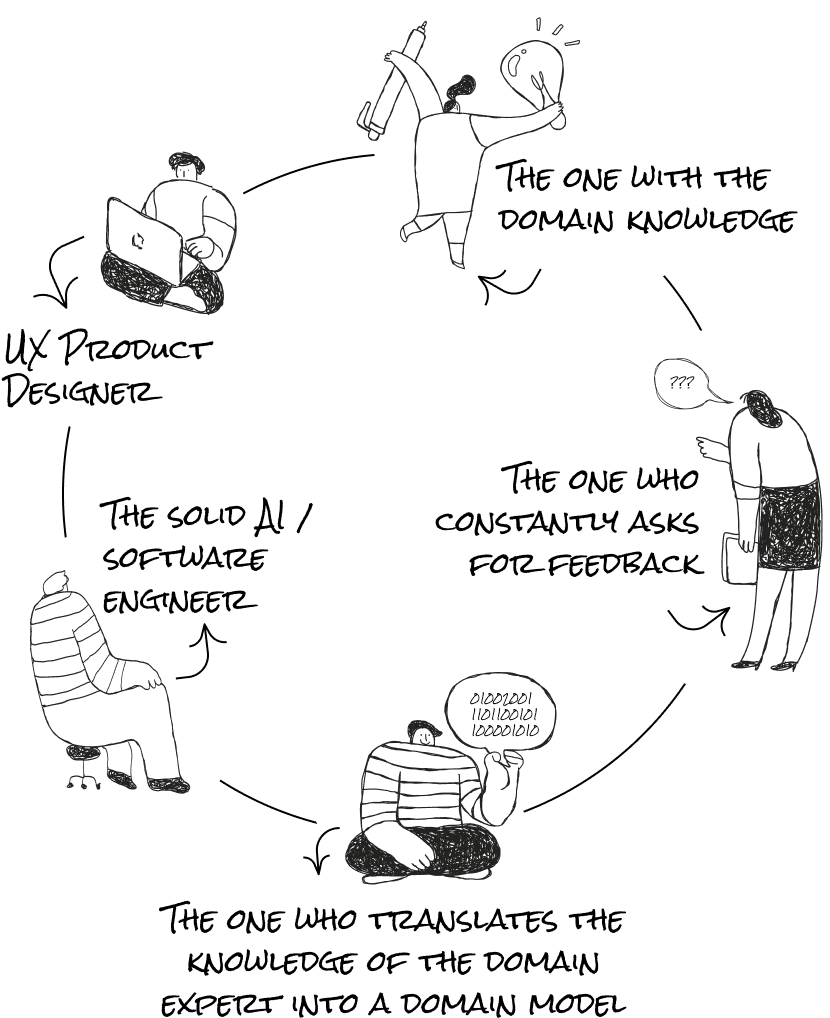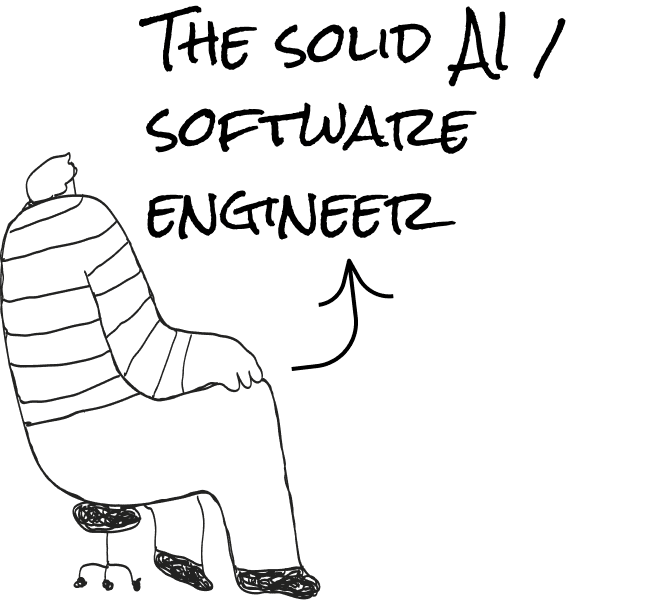5 roles every team needs to build good AI assistants
The development of good AI assistants for companies requires a team in which different specialists work together effectively. It requires not only technicians, but also subject matter experts, communicators, designers and strategists.
From the domain expert and software developer to the person who constantly asks for feedback: We show which 5 roles are central and which tasks they have to solve.
Would you like to know in advance which 8 practical tips teams can use to build successful AI assistants?
You can find this practical guide here:
The 5 central roles and their tasks
The domain expert (aka "Domain Expert")
The person with the company-specific knowledge
Yes, AI can deliver impressive results, but it cannot perform miracles. It is a misconception that language models such as GPT are easily capable of acquiring in-depth, company-specific knowledge if they are simply "fed" with enough documents. This ability to understand the complex details, nuances and interconnections of a company is primarily reserved for human expertise.
This knowledge lies with the company's experts, whom we at Trustbit refer to as "domain experts" in the context of domain-driven design. They are essential for integrating the fine details and interrelationships of the business environment into AI projects.
The most important tasks summarized:
-
Domain experts transfer their in-depth understanding of company-specific processes, products and services to the AI system in order to design it realistically and effectively.
-
You will be responsible for reviewing and evaluating AI performance to ensure continuous improvement and alignment with business objectives.
-
With their specialized knowledge, domain experts identify new applications for AI within the company and contribute to the strategic development of AI applications.
The Domain Model Expert
The person who translates the expertise into a domain model
The domain modeling expert in the context of Domain Driven Design (DDD) plays a central role in structuring the business logic required for the development of good AI systems.
This person analyzes and models the "business domain" based on the input of the domain experts in order to create a deep understanding of the business processes, rules and dependencies within the company. He or she ultimately translates this expertise into a so-called "domain model" (you could also call it a "knowledge map"), with which the AI assistance software is ultimately enriched in order to generate results that correspond to the business-specific logics and details.
The most important tasks summarized:
-
Facilitate communication between technical teams and subject matter experts to ensure that AI development is closely linked to business goals and strategies.
-
Capture and understand the organization's core concepts and processes to create a detailed model of the business domain.
-
Develop a coherent and simplified model that maps the business logic for AI development and serves as a bridge between technical implementation and business requirements.
-
Bringing together expert knowledge from different areas of the company to ensure a holistic view of the domain and inform the AI system accordingly.
The central communicator
The person who constantly asks for feedback
The person who constantly asks for feedback and acts as the central communicator is the link between the project team and the end users. Their main task is to ensure continuous communication to ensure that the development of the product or service is always aligned with the needs of the users. She systematically collects feedback, analyzes it and forwards the findings to the team in order to continuously improve product quality and user experience.
The most important tasks summarized:
-
Serves as the main communication channel between users and the development team and stakeholders in the company to effectively convey needs, expectations and experiences.
-
Regular collection of user feedback through surveys, interviews and user tests to gain a deep understanding of user experiences and needs.
-
Make decisions about the product roadmap and prioritization of tasks based on user feedback and business requirements.
-
Ensure that all team members are aligned around common goals and effectively coordinate collaboration between different functions and roles within the team.
The developer
The person who writes the code and doesn't get lost in complex architecture
The person who can program and has an understanding of patterns, pitfalls and the use of AI models is the technical core of the team. She uses her expertise to develop robust and efficient AI systems based on solid algorithms and data structures. Her experience with the nuances of AI allows her to not only create innovative solutions, but also identify and fix potential problems early on.
Particularly important: This person knows that complex architectures contribute nothing to product quality and that you move towards your goal step by step in iterative steps, guided by user feedback.
The most important tasks summarized:
-
Programming of AI systems taking into account the domain model in order to link the AI models with the subject-specific knowledge.
-
Provide technical expertise to the team to foster a deep understanding of AI principles and practices.
-
In order to test the quality of the AI assistant iteratively, the developer starts by providing a prototype. At the initial stage of the project, there is no need for a perfectly designed user interface, as this would be a waste of time for the time being.
(However, the expertise of a UX and design expert will be required at a later stage).
-
Adaptation of the existing system based on the data generated by the central communicator and feedback from the domain experts.
The UX Product Designer
The person who designs the ki assistant interface (the user interface)
The UX Product Designer is the person who designs the user interface and the so-called "user guidance" (the way in which you are guided through the software and use it).
Through her deep understanding of the users of the AI assistant, she creates easy-to-use interfaces that not only guide the effective use of the product, but also motivate them to share valuable feedback, which is essential for the further development of the AI assistant.
The most important tasks summarized:
-
Design intuitive user interfaces that guide users seamlessly through the functions of the AI system and encourage the exchange of feedback.
-
Direct interaction with end users in order to understand their experiences and needs in depth and incorporate them into the product design.
-
Use user feedback as a basis for continuous improvements to the user experience and to adapt AI functionalities.
-
Clear communication of the design solutions to those team members who implement the design and program the user interface.








